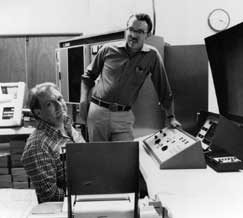|
|
James W. Christy and Robert Harrington (right) in 1978, U.S. Navy Image James Walter Christy (born 1938) is an American astronomer. Working at the United States Naval Observatory, on June 22, 1978 he discovered that Pluto had a moon, which he named Charon. The discovery was made by carefully examining an enlargement of a photographic plate of Pluto and noticing it had a very slight bulge on one side. This plate and others had been marked "poor" because the elongated image of Pluto was thought to be a defect resulting from improper alignment. However, Christy alertly noticed that only Pluto was elongated - not the background stars. Christy's earlier work at the Naval Observatory had included photographing double stars, so it occurred to him that this bulge might be a companion of Pluto. After examining images from observatory archives dating back to 1965, he concluded that the bulge was indeed a moon. [1] The photographic evidence was considered convincing but not conclusive (it remained possible that the bulge was a giant mountain on Pluto). However, based on Charon's calculated orbit, a series of mutual eclipses of Pluto and Charon was predicted and observed, confirming the discovery.[2] Ironically, the 1965 plates included a note "Pluto image elongated", but observatory astronomers, including Christy, assumed that the plates were defective until 1978.[3] In more modern telescopes, such as the Hubble Space Telescope or ground-based telescopes using adaptive optics, separate images of Pluto and Charon can very easily be resolved. References 1. ^ Planets Beyond: Discovering the Outer Solar System, by Mark Littmann, 1990, pgs. 173-177, including the essay "A Moment of Perception" by James W. Christy. 2. ^ Pluto and Charon: Ice Worlds on the Ragged Edge of the Solar System, by Alan Stern and Jacqueline Mitton, 1999, pg. 58 3. ^ Littmann, pg. 176 Links * Pluto's Companion from the website "Pluto: The Discovery of Planet X," by Brad Mager * 25th Anniversary of the Discovery of Pluto's moon CHARON from U.S. Naval Observatory website Retrieved from "http://en.wikipedia.org/"
|
|
|||||||||||
